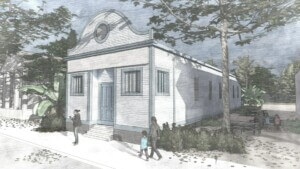As AN recently reported, the Urban Land Institute recently named four finalist in its 2015 Hines Competition to reimagine the Tulane/Gravier and Iberville neighborhoods in New Orleans: two multidisciplinary teams from Harvard University, one from Maryland University, and a joint team representing the University of Wisconsin-Milwaukee and the University of Wisconsin-Madison.
While four bold visions to reinvigorate the neighborhoods, only one could be crowned the winner and take home $50,000—and that winner is The Crossing by the University of Maryland team (see that project here). But here’s a closer look at the three finalists.
University of Wisconsin – Quartier Vert
As AN reported:
The University of Wisconsin team drew up plans for Quartier Vert, a phased development that capitalizes on the many new projects slated to open soon near Tremé and Tulane/Gravier. A desolate stretch of Canal Street would become an “outdoor lifestyle community” with restaurants, a hotel, apartments, and a medical office. The team would also build a green infrastructure network with stormwater runoff channels, retention ponds, and bioswales.”
Harvard University – The Grove
As AN reported:
One of the two Harvard teams imagined turning the space underneath the interstate into the Grove, a linear park with “a vast canopy lattice structure” that spans below the roadway. This structure, built of locally salvaged wood, would channel rainwater into retention ponds, planters, and subterranean catchment basins. The full scheme, called Claiborne Grove, also realigns part of Claiborne Avenue to encourage slower driving and to create safer streets. New residential developments, finished in pastels, are intended to evoke New Orleans’ famous shotgun homes in color and form.
Harvard University – Treme 2.0
As AN reported:
Harvard’s other team presented Tremé 2, a scheme that caters to the city’s changing demographics. For newly arrived millennials, the team proposes Complete Streets to foster walkable and enticing neighborhoods. This would also include an “affordable trendy retail complex.” For the city’s baby boomers there would be easily accessible transit services and health services. A pedestrian network that has both surface-level and elevated pathways called The Parade is set throughout the 23-acre site. The students also present an idea called the Portable Plantation, which uses interior courtyard spaces for urban agriculture projects.










